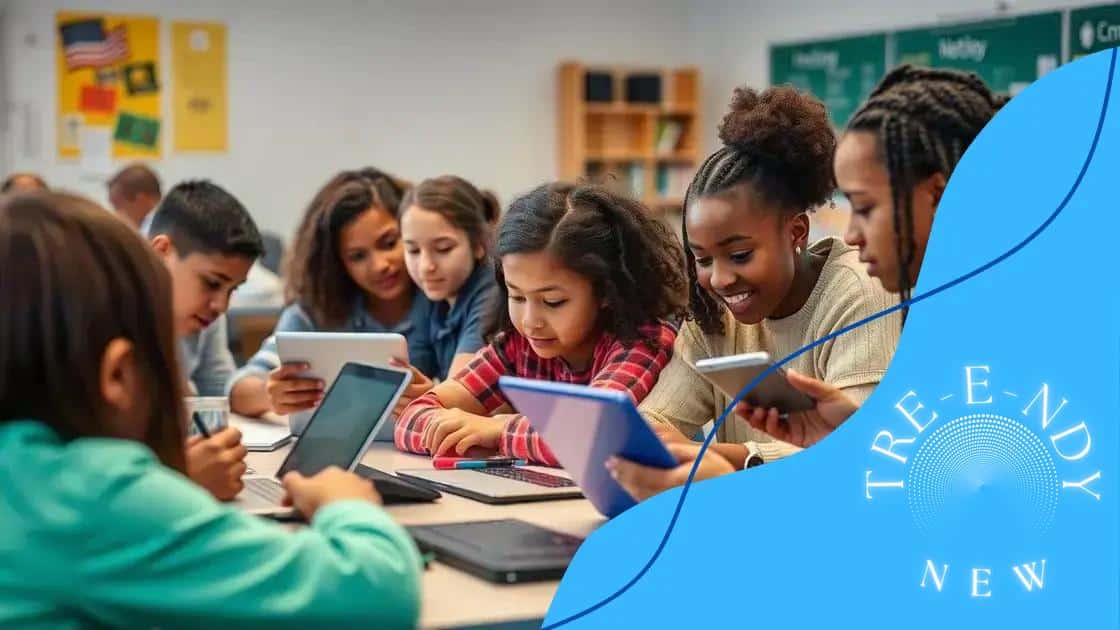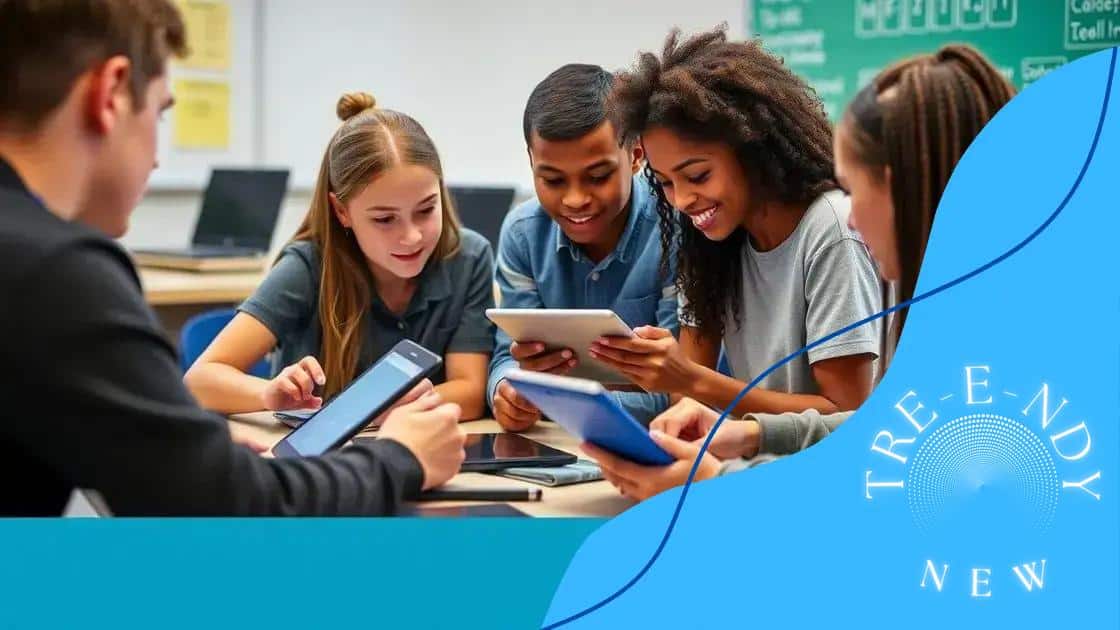Collaborative technology in classrooms: enhancing learning

Collaborative technology in classrooms enhances student engagement and teamwork by utilizing tools that facilitate communication, resource sharing, and immersive learning experiences, preparing students for the demands of the modern workforce.
Collaborative technology in classrooms is changing how students learn and interact with each other. Have you noticed how tech can boost teamwork and engagement among students? This article dives into the exciting world of educational technology.
Understanding collaborative technology
Understanding collaborative technology is vital in today’s classrooms. This technology enables students to work together seamlessly, enhancing their learning experiences. By using various tools and platforms, they can share ideas easily and support each other’s growth.
What is collaborative technology?
Collaborative technology refers to tools that allow multiple users to work on projects or assignments simultaneously. This creates a more interactive learning environment. Students can communicate in real-time, regardless of their location, making learning more engaging and efficient.
Key features of collaborative technology
- Real-time editing: Multiple users can work on files together.
- Instant communication: Chat and video options help connect students.
- File sharing: Easy access to shared resources enhances collaboration.
As we explore the importance of these tools, we see that they not only improve communication but also develop critical thinking and problem-solving skills. For example, group projects become less daunting when teamwork is supported by technology. Students often feel more confident sharing their opinions and contributions.
Additionally, the flexibility of collaborative tools allows for various teaching methods. Teachers can assign group work that adapts to different learning styles. This means every student has the chance to participate and shine.
Why is it important?
Collaborative technology fosters a sense of community among students. When they learn to work together, they understand different perspectives and respect each other’s ideas. This builds teamwork skills essential for future careers.
Overall, embracing collaborative technology in classrooms not only enhances learning but also prepares students for real-world challenges. The interactive environment created by these tools leads to improved academic performance and greater student satisfaction.
Benefits of collaboration tools for teachers
Benefits of collaboration tools for teachers extend beyond simple convenience. These tools create a more dynamic educational environment, allowing teachers to share resources, lesson plans, and ideas in real-time. With the right technology, teachers can connect and collaborate more effectively, ultimately improving student learning outcomes.
Enhanced communication
Collaboration tools foster better communication among educators. Instant messaging and video conferencing platforms allow teachers to discuss strategies and share experiences without needing to be in the same room. This seamless communication strengthens professional relationships and supports teamwork.
Resource sharing
- Teachers can access and share teaching materials effortlessly.
- Collaborative tools allow for the storage of digital resources in one place.
- Shared lesson plans and assignments can enhance classroom activities.
Resource sharing not only saves time but also enriches the learning experience. When teachers share their best practices, everyone benefits. They can easily adapt materials to meet the needs of their students, which leads to improved engagement and understanding.
Furthermore, collaboration tools can facilitate joint projects and co-teaching opportunities. By collaborating, teachers can combine their strengths to develop more comprehensive lessons. Students also perceive teamwork as an essential skill, and seeing teachers model this behavior encourages them to do the same.
Professional development
Using collaboration tools, teachers can participate in online workshops and professional learning communities. This access to ongoing education benefits them by providing new techniques and approaches that improve classroom management and instruction.
In summary, the benefits of collaboration tools for teachers create a more connected and engaged teaching environment. By enhancing communication, promoting resource sharing, and supporting professional development, these tools ultimately contribute to better educational experiences for both teachers and students.
Practical examples of technology in classrooms

Practical examples of technology in classrooms show how educators can enhance student learning. By integrating various tools, teachers can create opportunities for active participation and collaboration. Let’s explore some effective ways technology is being used in educational settings.
Interactive whiteboards
Interactive whiteboards have transformed traditional teaching methods. Teachers can display lessons, share videos, and engage students in discussions through touch-sensitive screens. This technology encourages students to participate actively, making learning more fun.
Learning management systems (LMS)
- Platforms like Google Classroom and Moodle help teachers organize materials.
- Students can access resources and assignments easily.
- LMS enables tracking of student progress and communication with parents.
These systems allow for a blended learning approach, where students can learn at their own pace while still participating in classroom activities. It fosters a more personalized learning experience.
Virtual reality (VR) in education
Virtual reality is changing how students experience learning. Imagine exploring ancient ruins or the depths of the ocean without leaving the classroom. VR allows students to immerse themselves in their subjects, making complex concepts easier to understand and remember.
Moreover, using tools like VR headsets provides a hands-on experience that’s often more memorable than traditional lectures. This engagement leads to better retention of knowledge.
Online collaborative projects
Technology facilitates collaboration among students through online platforms. Tools like Padlet or Microsoft Teams enable students to work on group projects from different locations. They can share ideas, give feedback, and create content together in real-time.
This skill of collaboration is vital for future job markets, as workplaces increasingly require effective teamwork regardless of location. By using these technologies, students are not only learning the subject matter, but also essential life skills.
Challenges in implementing collaborative tech
Challenges in implementing collaborative tech can sometimes hinder its effectiveness in classrooms. While technology has great potential to enhance education, several obstacles may arise during its integration.
Tech infrastructure limitations
One major challenge is the availability of adequate tech infrastructure. Many schools struggle with outdated equipment or slow internet connections, making it hard for teachers and students to use collaborative tools effectively.
Training and support for teachers
- Teachers may not have adequate training on how to use new tools.
- Continuous support is necessary as technologies evolve.
- Lack of training can lead to frustration and underutilization of resources.
Proper training and ongoing professional development are essential for successful implementation. Without it, teachers might feel overwhelmed and avoid using the technology altogether.
Resistance to change
Another challenge is resistance to change from both educators and students. Some may prefer traditional teaching methods and feel uncomfortable adapting to new tools. This resistance can slow down the adoption of collaborative technology.
Differences in student access
Another issue is the disparity in access to technology among students. Not every student may have access to devices or reliable internet at home, leading to inequalities in learning opportunities. Schools must find ways to ensure all students can participate.
Overcoming these challenges requires a concerted effort from school leaders, educators, and the community. Collaboration among all parties can help create solutions that enhance the learning experience.
Future trends in collaborative education
Future trends in collaborative education indicate a shift toward more integrated and interactive learning environments. As technology continues to evolve, classrooms are becoming places where collaboration flourishes, fostering skills essential for the future.
Increased use of artificial intelligence
Artificial intelligence (AI) is set to play a significant role in collaborative education. AI tools can personalize learning experiences, adapting to the individual needs of students. This allows for better collaboration by matching students with complementary skills for group projects, enhancing teamwork.
Growth of online and hybrid learning
- Online platforms will continue to expand, offering greater access to diverse educational resources.
- Hybrid learning models will blend in-person and online methods, providing flexibility.
- Collaborative tools will help manage interactions in these mixed environments.
The growth of online options means students can collaborate with peers from around the world. This broadens perspectives and encourages cross-cultural understanding, which is vital in today’s global society.
Emphasis on social-emotional learning
As education focuses more on social-emotional learning, collaboration will be essential. Learning to work with others, resolve conflicts, and communicate effectively are skills students must develop. Future collaborative education will prioritize activities that build these skills, making group work even more meaningful.
Integration of virtual and augmented reality
Virtual and augmented reality (VR and AR) technologies are becoming increasingly important in classrooms. These tools can create immersive environments where students can work together on projects and simulations. It adds an exciting aspect to collaboration, making learning engaging and impactful.
As we look ahead, it’s clear that collaborative education is transforming. By embracing future trends, educators can prepare students for a world where teamwork and cooperation are paramount.
FAQ – Frequently Asked Questions about Collaborative Technology in Classrooms
What is collaborative technology?
Collaborative technology refers to tools and platforms that enable students to work together on projects and assignments, enhancing teamwork and communication.
How can collaborative tools benefit teachers?
Collaborative tools help teachers communicate better, share resources, and develop lessons together, ultimately improving the learning environment.
What challenges do schools face when implementing collaborative tech?
Schools often encounter limitations in tech infrastructure, resistance to change, and the need for proper training and support for teachers.
What are some future trends in collaborative education?
Future trends include increased use of artificial intelligence, growth of online and hybrid learning, and greater emphasis on social-emotional learning and immersive technologies.





